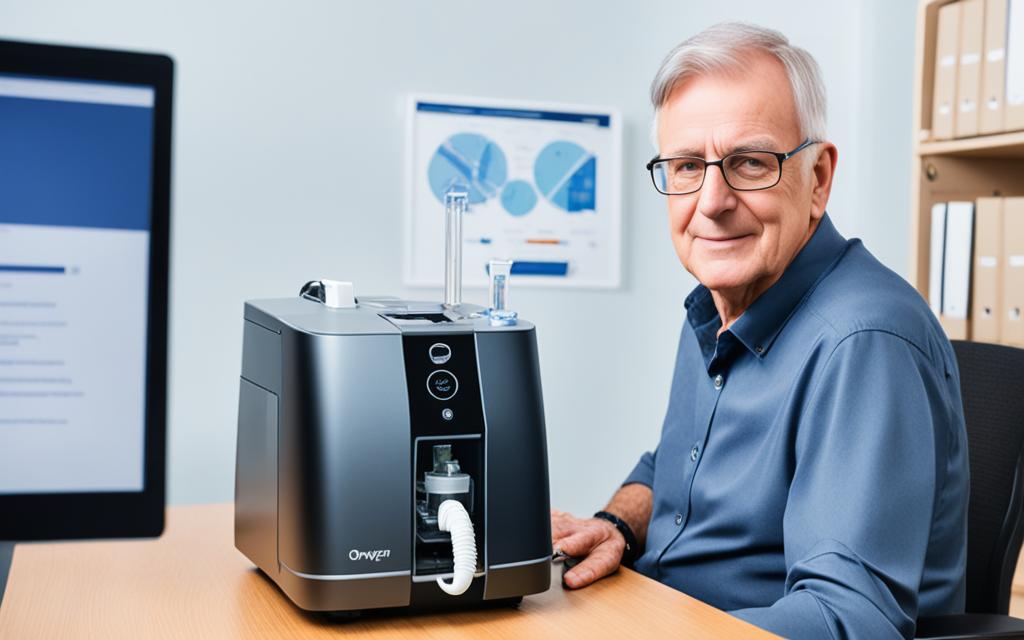It’s possible to use a computer while on oxygen therapy if you take the right steps. You must follow safety guidelines to stay safe and keep being productive online while using oxygen.
When using oxygen concentrators, make sure to keep up with monthly battery checks. This ensures you always have power1. Keeping your concentrator clean is also key, just like looking after your laptop1. If you have questions, you can call customer service at the number given1.
Be careful with what you do on your computer. Don’t smoke near oxygen machines because it’s a fire risk2. Also, avoid using things like hair dryers and curling irons with oxygen on2. Sleeping with oxygen? Use 100 percent cotton bedding to cut down on static electricity2.
Key Takeaways:
- Keeping your oxygen concentrator clean and well-maintained is crucial for its best performance1.
- Stay away from smoking and electrical devices near oxygen gear to avoid fires2.
- Choose 100 percent cotton bedding to lower the chance of static shock when sleeping with oxygen2.
Safety Tips for Using Oxygen Concentrators
Using oxygen concentrators safely is key to their proper use and accident prevention. Here are some tips to help you use your oxygen concentrator safely and with confidence:
- Regularly change filters: Change the gross particle filter at least once a year1. This keeps your oxygen concentrator working well by preventing clogs.
- Replace the cannula: Change cannulas every month to keep them in good condition1.
- Run the concentrator regularly: Use your oxygen concentrator for at least 4 hours a month1. This keeps it working well by stopping moisture buildup.
- Drain the batteries: Drain the batteries fully once a month to make them last longer1.
- Treat the concentrator like a laptop computer: Keep your device clean and dry to keep it working. Clean the filter with water and mild dish soap once a month3. Don’t expose it to extreme temperatures or physical damage3.
Oxygen concentrators work differently from oxygen tanks. They clean and concentrate air to give you 90%-95% oxygen3. So, they don’t need the careful handling of oxygen tanks, making them safer to use and store3.
Preventing Common Hazards
Be aware of the risks when using oxygen concentrators and take steps to avoid them. Here are some important safety tips:
- Avoid leaving the concentrator in a hot car: High heat can harm the device and reduce its performance. Always keep it in a cool, well-ventilated spot.
- Keep the concentrator dry: Moisture can damage the device and cause electrical shocks. Keep it away from water and ensure it stays dry.
- Do not run the concentrator without using it: Running it without need can strain the device and shorten its life. Use it only when you need oxygen therapy.
- Avoid confined spaces: Make sure the concentrator has good airflow. Don’t store it in small spaces that don’t let air circulate well.
- Avoid smoking near the concentrator: Oxygen can ignite easily, making it a fire risk. Keep it away from flames and flammable things.
If you have questions or concerns about using your oxygen concentrator safely, talk to your supplier or healthcare professional. They can give you advice tailored to your needs.
Safety Precautions for Using Supplemental Oxygen
Using supplemental oxygen requires careful safety steps to keep people safe and prevent accidents. This part covers important safety tips and guidelines for using supplemental oxygen to reduce risks and keep the environment safe.
Proper Storage and Ventilation
Storing oxygen equipment right is key to avoid damage and fire risks. Oxygen tanks should be kept upright and in a place with good airflow, away from heat sources4. They should be at least 10 feet away from things like lighted fireplaces and heaters4. This keeps the risk of accidental ignition low and ensures safety.
Avoid Flammable Substances
Oxygen is highly flammable, so it must be kept away from things that can catch fire easily. People using oxygen should not smoke or be near open flames or heat, like gas stoves or candles54. Also, things like oils and air fresheners with alcohol can be dangerous with oxygen; keep them away from oxygen gear46.
Regular Sanitization and Maintenance
Keeping oxygen accessories clean is vital for their proper function and to avoid contamination. Items like tubing and masks should be cleaned as the American Lung Association suggests5. Cleaning them right reduces infection risks and makes oxygen equipment last longer.
Emergency Preparedness
Being ready for emergencies is key when using supplemental oxygen. If the power goes out, having a big oxygen tank or a backup generator is a good idea5. Also, make sure smoke alarms and fire extinguishers are installed and checked often5. Being prepared helps keep a safe space for those using oxygen.
By taking these safety steps, people using supplemental oxygen can enjoy its benefits safely. It’s important to always put safety first to keep both oxygen users and their helpers safe and at ease.
Importance of Supplemental Oxygen for COPD Patients
Supplemental oxygen is key for treating Chronic Obstructive Pulmonary Disease (COPD), especially for those with a big drop in lung function. It brings oxygen-rich air to the lungs, helping with oxygen absorption. This reduces the risk of hypoxemia, or low oxygen in the blood. It greatly benefits COPD patients, making their lives better and improving their quality of life.
Supplemental oxygen therapy aims to ease COPD symptoms like breathlessness and tiredness. It increases oxygen in the body, helping to fight the lung damage from COPD. This leads to easier breathing, more energy, and less fatigue. Patients can then do daily tasks with more ease and comfort.
Using supplemental oxygen also boosts exercise ability. Studies show it helps COPD patients do better in exercises, alone or with rehab. Before starting rehab, oxygen therapy added 75 seconds to exercise time. After rehab, the increase was 153 seconds with oxygen. Rehab alone added 28 seconds, but oxygen made it even better, adding 78 seconds more.
Supplemental oxygen also has other benefits for COPD patients. It reduces lung strain and helps with breathing efficiency. It eases shortness of breath and improves exercise ability. Even for those with mild COPD, oxygen therapy can help ease symptoms and improve physical strength. But, it’s crucial to use oxygen under a doctor’s guidance, based on the patient’s lung function and oxygen levels7.
Pulmonary rehabilitation is also vital for COPD patients. It greatly improves exercise ability and reduces strain on the lungs. But, it’s not clear how it affects oxygen use in COPD patients. Not all COPD patients need oxygen, but comprehensive care and tailored treatment plans are key for the best outcomes7.
In conclusion, supplemental oxygen is crucial for COPD patients with serious lung damage. It helps with symptoms, boosts exercise, and reduces lung strain. With rehab, its benefits are even greater, helping patients manage their condition better. Healthcare professionals should create personalized plans that include oxygen therapy and other treatments for the best COPD care7.
Potential Dangers of Using Supplemental Oxygen
Supplemental oxygen is usually safe when used right. But, it’s key to know the dangers it can bring. The big risk is its flammability, which means it can make things burn faster.
Leaky tanks and oxygen leaks can be very dangerous. They can make things nearby catch fire easily. This is a big risk to people and things around.
There are other risks too. Using oxygen bars for fun can cause lung problems. Some people might get headaches, feel dizzy, have trouble breathing, or get worse asthma symptoms.
Too much supplemental oxygen can be bad, even if you need it for health reasons. In some cases, it can actually increase the risk of death. Always follow the advice of doctors and stick to the right amount of oxygen.
Oxygen bars can be risky because they can make fires start, not because oxygen burns easily. These places charge a lot per minute, but they’re not checked by the FDA. So, they must be very clean to avoid germs.
It’s important to be careful with supplemental oxygen and follow safety rules. This helps avoid dangers and keeps people safe who need it for health.
Reference:8
Benefits of Using Supplemental Oxygen
Using supplemental oxygen can greatly help COPD patients. It boosts blood oxygen levels, making breathing easier and reducing tiredness. It also helps with exercise, heart function, and boosts energy.
It lowers the risk of not having enough oxygen, sleep problems, and COPD complications. This can make people with breathing issues feel better, more alert, and improve their life quality.
Studies show that continuous oxygen therapy can increase survival chances for those with severe COPD9. There are different oxygen therapy options, like portable tanks for freedom9. Concentrators are cheaper and don’t need tank refills9. Liquid oxygen is very concentrated, fitting more oxygen in a small tank9.
Hyperbaric oxygen therapy is another type that uses pressurized chambers for pure oxygen9. It’s often used for serious infections or wounds.
Oxygen can be given through nasal cannulas, masks, or even incubators for babies9. These methods help provide the right amount of oxygen for each person.
Supplemental oxygen does more than just help physically. It can make life better, improve how mobile someone is, and even increase life expectancy9. It helps with symptoms like headaches and fatigue caused by low oxygen levels9. It also helps children with lung problems grow and develop well9.
It’s key to talk to doctors and specialists to find the right oxygen flow and method for you10. They can tailor oxygen therapy to your needs for the best results10.
To learn more about supplemental oxygen and COPD treatment, check out these resources:
- Healthline – Oxygen Therapy
- Oxygen Concentrator Store – Oxygen Concentrator and Therapy
- NCBI – Oxygen Therapy in COPD
Tips for Using Oxygen Safely
Using oxygen therapy requires careful steps to avoid leaks and fire risks. By sticking to guidelines and being cautious, you can make sure everyone stays safe.
Start by turning the oxygen tank valve slowly and carefully. Check the tubing and connections often for any damage or loose parts. If you find leaks, immediately report and address the issue to stop any dangers11.
It’s vital to store oxygen tanks in a well-ventilated area, away from places like under the bed or in car trunks. Keep them near an exit for easy access in emergencies11.
Using clean, well-maintained equipment is key for safety and effectiveness. Clean and replace parts as needed. For example, change facemasks every 2-4 weeks, cannulas every 2-4 weeks, and tubing monthly11. Regular medical check-ups help keep your oxygen flow right11.
Being ready for emergencies is crucial. Keep extra oxygen supplies like tanks, cannulas, and masks handy. This way, you’re prepared for any sudden needs or oxygen shortages11.
| Precautions for Oxygen Safety | Prevent Leaks | Minimize Fire Hazards |
|---|---|---|
| Store oxygen tanks in a well-ventilated space | Regularly check for leaks in tubing and connections | Keep flame sources at least 5 feet away from the oxygen unit12 |
| Keep tanks away from heat sources and flammable materials | Report and address any leaks immediately | Avoid smoking or using electronic cigarettes12 |
| Ensure the home is smoke-free | Store extra oxygen therapy supplies for emergencies | Use water-based products instead of flammable ones12 |
| Regularly clean and replace oxygen therapy equipment | Attend regular medical check-ups and adjust oxygen flow rate if necessary | Ensure hands are fully dry before touching the oxygen unit12 |
Oxygen therapy can greatly improve life for those with lung diseases and other conditions. But, it’s crucial to focus on safety to avoid risks. By following these precautions, you can use oxygen safely and with confidence.
Preventing Oxygen Leaks
It’s vital to prevent oxygen leaks to keep people safe who use oxygen. By taking the right safety steps and handling it correctly, we can lower the risk of leaks and dangers.
Safety Precautions:
- Slowly turn the valve on the oxygen tank when using it to avoid sudden releases of oxygen.
- Make sure the valve on the oxygen tank is fully closed when not in use to stop leaks and save money.
- Check the oxygen tank and valves regularly for any wear or damage. Fix any problems quickly.
- Keep oxygen tanks upright when storing them to reduce the chance of damage or leaks.
- Use clean, undamaged tubing for oxygen therapy to avoid leaks.
Reducing Leakage Risk:
Leaks with oxygen tanks are common but can be lowered with the right steps. Following safety rules and handling with care can stop leaks and dangers.
Statistical data from link 1:
Oxygen tanks can explode in fires due to high temperatures, causing them to burst. They have a special plug that opens to ease pressure without an explosion in a fire. Unlike tanks of flammable liquids, oxygen tanks don’t ignite easily and need a flame or spark to explode. To prevent explosions, store and handle oxygen tanks safely and keep them in good condition. Even though oxygen tanks are made to be stable, they can still explode if not handled correctly. If you see an oxygen tank explode, move away quickly, call for help, get medical attention for injuries, and report the incident.
By sticking to these safety steps and checking regularly, we can cut down the risk of oxygen leaks. This makes using supplemental oxygen safer. Always put safety first when working with oxygen to avoid dangers and keep a safe place.
Keep Heat and Flame Away From Your Oxygen
To keep oxygen safe and prevent fires, it’s vital to keep heat and flames away from your oxygen. Heat and flames can cause combustion, which is a big risk for people using oxygen.
Don’t use oxygen near open flames like stoves, candles, or lighters. Keep a safe distance of at least five feet from heat sources like gas burners and space heaters.
Never smoke or let others smoke near oxygen. Smoking can start a fire or cause an explosion. Also, don’t wear your nasal cannula near a gas stove as it increases fire risk.
Statistics from Inogen13 show that portable oxygen concentrators, like the Inogen® range, give a lot of oxygen for people needing breathing help. These devices are safe and efficient, but safety rules are key.
Using an oxygen concentrator doesn’t change the oxygen level in the room much. Data from IRV214 says these devices increase oxygen from 20% in normal air to 90-95% pure oxygen. But in an RV, the device’s capacity is small compared to the RV’s size, so it doesn’t make the air too rich for fires.
Other safety steps include keeping oxygen tanks in a stand or cart to stop them from tipping. Home Health Solutions15 suggests keeping extra tanks flat on the floor, not upright, for safety.
Also, be careful with electrical safety when using oxygen concentrators. Only plug them into grounded outlets and don’t use extension cords to avoid electrical dangers.
Don’t keep oxygen systems near heat or things that can start a fire. Always have a plan for leaving the house in case of a fire while using oxygen.
Follow these safety tips and keep heat and flames away from your oxygen to stay safe. Always talk to a healthcare provider to make sure you’re using the right amount of oxygen and to check if your therapy is working well.
| Important Tips for Oxygen Safety |
|---|
| Avoid using oxygen near open flames such as stoves, candles, and lighters. |
| Maintain a safe distance of at least five feet from heat sources including gas burners and space heaters. |
| Never smoke while using oxygen or wear your nasal cannula near a gas stove. |
| Store oxygen tanks in a stand or cart to prevent tipping or falling. |
| Store extra unsecured tanks flat on the floor, not standing or leaning upright. |
| Plug concentrators into properly grounded outlets and avoid using extension cords. |
| Avoid storing oxygen systems near heat or ignition sources. |
| Plan an evacuation route in the event of a fire while using oxygen in the home. |
Proper Storage and Transportation of Oxygen Tanks
Storing and moving oxygen tanks safely is key for those on oxygen therapy. It’s vital whether you’re at home or out and about. Following the right steps helps avoid accidents and keeps oxygen flowing smoothly.
Keep oxygen tanks in a spot with good airflow, away from flammable things or high heat16. This stops dangerous gases from building up and keeps the cylinders safe from getting too hot. Heat can be a big risk.
Make sure oxygen cylinders are laid flat or in a cart to stop them from falling or moving16. This keeps them safe and lowers the risk of damage or injury.
Under the bed storage needs good airflow and careful placement to prevent harm16. Place the cylinders in a spot that lets oxygen flow well, keeping them away from where people sleep.
When moving oxygen tanks, make sure they’re secure, whether in a car or with transport services16. In a car, tie them down and keep them flat or upright in a special rack. Always open a window for air and don’t smoke inside.
Liquid oxygen tanks must be kept upright when moving to avoid spills16. Don’t put them in tight spaces or near heat sources that could make oxygen release faster. Good airflow around the tanks helps keep them cool and safe.
Following safety rules for storing and moving oxygen tanks is key for patients on oxygen therapy16. Doing this reduces the chance of accidents and keeps oxygen supplies safe and steady.
| Safety Guidelines for Oxygen Tank Storage and Transportation |
|---|
| – Store oxygen tanks in a well-ventilated space away from gas, open flames, or areas with temperatures exceeding 120 degrees Fahrenheit |
| – Secure cylinders lying down, unstacked, or using a cylinder base cart, rack, or system provided by the supplier |
| – Ensure proper ventilation and safe positioning when storing cylinders under a bed |
| – Secure oxygen cylinders during transportation to prevent movement and use a dedicated storage rack in a vehicle |
| – Keep liquid oxygen tanks upright during transportation and avoid storing them in enclosed spaces or near sources of heat |
Importance of Being Prepared and Monitoring Oxygen Equipment
Being ready is key when using oxygen. It keeps you safe and makes sure you always have enough oxygen. With new tech and more patients needing oxygen, there are now more options for home use17. It’s important to know about these options and pick the right one for you.
New tech has changed oxygen therapy, moving from constant flow to intermittent flow17. This change makes using oxygen better and more efficient. But, we need more research and help from doctors and therapists to make sure these new devices are safe and work well17.
For long-term oxygen use, it’s important to adjust the oxygen levels for different activities17. New guidelines are needed to make sure oxygen levels are right and there’s no too little or too much oxygen. Checking on patients regularly is key to seeing how well long-term oxygen therapy is working17. But, checking too often can be hard and might not always help patients as much as we hope17.
Home oxygen machines give oxygen that’s 90% ± 5% pure17. This is close enough to the 99% purity in hospitals for most patients. The cost of oxygen therapy affects the development of new equipment17. Finding a balance between cost and how well the equipment works is crucial.
New oxygen products are slow to be used because there’s not enough research and they’re not well covered by insurance17. So, we focus more on the equipment than on making sure patients get enough oxygen. To fix this, we need more studies and evidence to support new products and better insurance policies.
To keep oxygen therapy safe and effective, being ready and checking your equipment is key. Here are some important tips:
- Have fire extinguishers and smoke alarms ready at home. They help you and others act fast if there’s a fire17.
- Always have a backup oxygen setup. This means you won’t be without oxygen if something goes wrong or in an emergency17.
- Tell your oxygen supplier about your oxygen needs and when you need refills. This stops you from running out of oxygen and keeps your supply steady17.
- Check the gauges on your oxygen gear often. This lets you spot any maintenance or problems early, so you can fix or replace them quickly17.
Being ready and watching your oxygen gear closely keeps you safe and makes sure you always have oxygen. This careful approach makes treatment better and more comfortable for you.
Conclusion
Using oxygen safety steps and guidelines for oxygen devices makes it safe to use a computer with oxygen therapy. It’s important to keep safe, avoid leaks, and reduce fire risks for a secure digital experience18.
A survey showed many people need portable oxygen devices for better health and life quality18. They feel anxious and isolated if their oxygen gear doesn’t fit their needs.
Studies found different oxygen devices work better for some people with COPD and ILD during exercise19. It’s key to pick the right device for each person to better their health and life.
Oxygen devices are crucial for treating many health issues like COPD and cystic fibrosis20. Online forums let people share their oxygen therapy stories and get advice. This helps them learn how to keep their devices working well and fix common issues20.
FAQ
Can I use a computer while on oxygen therapy?
Yes, you can use a computer with oxygen therapy. Just take the right steps and follow safety rules.
What are the safety tips for using oxygen concentrators?
Keep your oxygen concentrator safe by changing filters often and using a new cannula. Run it for a bit each month and drain the batteries. Treat it like a laptop. Don’t leave it in a hot car, get it wet, or use it without oxygen. Keep it away from small spaces and smoking.
What are the safety precautions for using supplemental oxygen?
Keep oxygen away from heat and flames. Don’t use aerosols or flammable creams with it. Store it upright in a well-ventilated area. Have smoke alarms and fire extinguishers ready. Keep a big oxygen tank or a backup generator for power cuts.
Why is supplemental oxygen important for COPD patients?
Supplemental oxygen is key for COPD patients. It brings oxygen-rich air to the lungs, helping with oxygen absorption. This improves symptoms like breathlessness and fatigue, and lowers the risk of complications. It makes life better for COPD patients.
What are the potential dangers of using supplemental oxygen?
Oxygen is flammable, making things more likely to catch fire. Leaks increase the risk of fires or explosions. Using oxygen equipment wrongly can also cause big fires or explosions.
What are the benefits of using supplemental oxygen?
Supplemental oxygen helps COPD patients a lot. It boosts oxygen levels, reducing breathlessness and tiredness. It also helps with exercise, heart function, and energy levels.
It lowers the risk of sleep problems and COPD complications. This improves mood, alertness, and life quality for those with breathing issues.
How can I use oxygen safely?
Use oxygen safely by stopping leaks and avoiding fires. Be careful with the tank valve, check for leaks often, and store tanks right. Use clean tubing and keep away from heat and flames.
Be careful while cooking and avoid open flames. Never smoke or use e-cigarettes with oxygen. Follow safety rules and guidelines closely.
How can I prevent oxygen leaks?
Stop leaks by handling your equipment carefully. Turn the tank valve slowly and make sure it’s closed when not in use. Check the tank and valves for damage often.
Store tanks upright and use clean tubing. Some leaks are normal, but these steps can reduce risks and make oxygen use safer.
How can I keep heat and flame away from my oxygen?
Keep oxygen away from heat and flames. Don’t use it near open flames like stoves or candles. Keep a safe distance from heat sources like gas burners and heaters.
Never smoke or wear your nasal cannula near gas stoves. These steps help avoid combustion and fire risks.
What are the proper storage and transportation guidelines for oxygen tanks?
Store oxygen tanks upright always. Don’t keep them in small spaces or near heat. Don’t cut tubing or use long extensions.
Turn off the oxygen when not in use and don’t cover the concentrator. Following these rules reduces leak and accident risks.
Why is it important to be prepared and monitor oxygen equipment?
Being ready is key with oxygen therapy. Have fire extinguishers and smoke alarms ready. Keep backup equipment and tell your oxygen supplier when you need refills.
Check oxygen equipment gauges often. Being alert and prepared keeps you safe and ensures you always have oxygen.
Can I use a computer while on oxygen therapy?
Yes, you can use a computer with oxygen therapy. Just be careful and follow safety advice. This way, you can stay safe and keep up with work or hobbies while using oxygen therapy.
Source Links
- https://www.oxygenconcentratorstore.com/blog/dos-and-donts-of-oxygen-concentrators/ – The Do’s and Don’ts of Oxygen Concentrators
- https://action.lung.org/pf/OX3-Using_Oxygen_Safely/files/OX3-Using_Oxygen_Safely_Option2-2020-v2.pdf – PDF
- https://www.webmd.com/lung/oxygen-concentrator-what-is – What Is an Oxygen Concentrator?
- https://www.apria.com/home-healthcare-insights/best-tips-for-storing-and-using-oxygen-safely-at-home – Best Tips for Storing and Using Oxygen Safely at Home
- https://www.ncoa.org/adviser/oxygen-machines/home-oxygen-safety/ – Safety Tips for Using Supplemental Oxygen Therapy
- https://lptmedical.com/blogs/respiratory-resource-center/oxygen-safety-43-tips-you-need-to-know – Oxygen Safety: 43 Tips You Need to Know
- https://www.ncbi.nlm.nih.gov/pmc/articles/PMC2866201/ – Effects of oxygen on exercise duration in chronic obstructive pulmonary disease patients before and after pulmonary rehabilitation
- https://www.healthline.com/health/oxygen-bar – Oxygen Bar: Benefits, Risks, What to Expect, Cost, and More
- https://www.healthline.com/health/oxygen-therapy – Oxygen Therapy | Definition and Patient Education
- https://www.ncbi.nlm.nih.gov/pmc/articles/PMC7070269/ – Automated Home Oxygen Delivery for Patients with COPD and Respiratory Failure: A New Approach
- https://www.apria.com/home-healthcare-insights/new-to-oxygen-therapy-heres-what-you-need-to-know – New to Oxygen Therapy? Here’s What You Need to Know!
- https://oumedicine.staywellsolutionsonline.com/Library/HealthSheets/3,S,82463 – Using Oxygen Safely | OU Health
- https://www.inogen.com/oxygen-therapy/safety-of-portable-oxygen-concentrators/ – Portable Oxygen Concentrator Safety Precautions | Inogen
- https://www.irv2.com/forums/f59/using-oxygen-concentrator-in-rv-452656.html – Using Oxygen Concentrator in RV
- https://homehealthsolutions.com/resources/oxygen-safety-instructions/ – Oxygen Safety Instructions – Home Health Solutions
- https://www.apria.com/home-healthcare-insights/how-to-use-a-portable-oxygen-cylinder – How To Use a Portable Oxygen Cylinder
- https://rc.rcjournal.com/content/58/1/65 – Options for Home Oxygen Therapy Equipment: Storage and Metering of Oxygen in the Home
- https://www.thoracic.org/about/newsroom/press-releases/conference/lindell-oxygen-delivery-systems.php – Patients With Lung Disease Say Current Home Oxygen Delivery Systems Do Not Meet Their Needs, Increase Their Isolation
- https://rc.rcjournal.com/content/58/10/1606 – Are Oxygen-Conserving Devices Effective for Correcting Exercise Hypoxemia?
- https://lptmedical.com/blogs/respiratory-resource-center/oxygen-troubleshooting-easy-fixes-for-the-most-common-errors – Oxygen Troubleshooting: Easy Fixes for the Most Common Errors


















